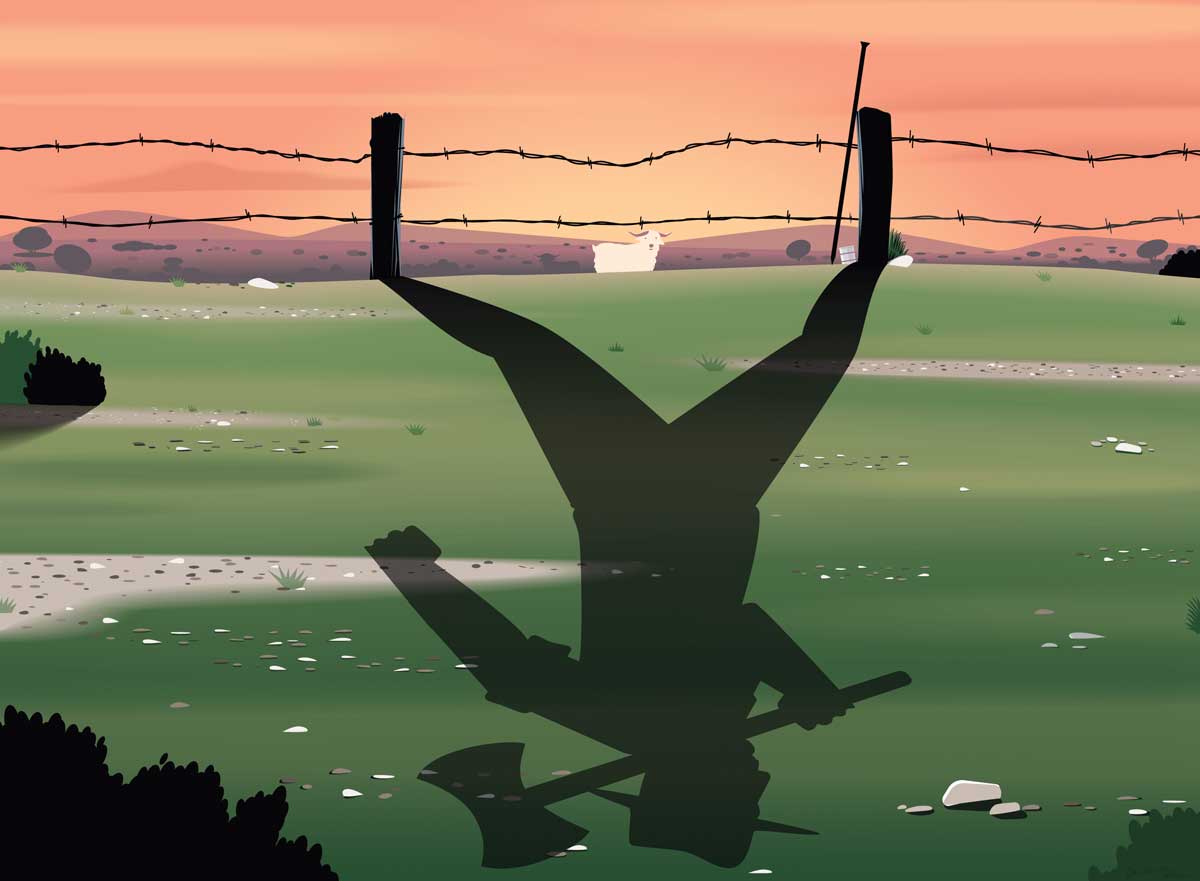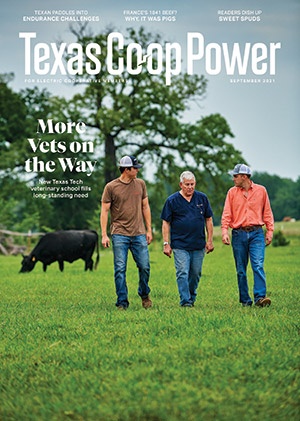Where do fences come from? This was a question that crossed my mind as I picked my way through a fractured, untracked, 2,000-acre “pasture” in Edwards County, persuasively one of the more remote corners of the Hill Country. The limestone strata rippled and crumbled beneath my boots like a quinceañera cake dropped in a dumpster a few thousand years ago. Tasajillo, agarita, prickly pear, mesquite and other underbrush pestered my pant legs and sleeves. Walking in a straight line was impossible. And yet, here, stubbornly striding across the ridge, 3 miles from the nearest excuse for a road, another 5 from an actual road, was a straight line: a fence.
This was once goat country, good for little else. Not enough forage to put meat on cattle but enough to put wool—mohair—on Angora goats, historic denizens of Central Asia. A century or so ago, some sunburnt savant had the wild idea that the Edwards Plateau looked a lot like Anatolia; and then came the First World War, when the Ottomans joined up with the Germans and kept their wool to themselves.
With lightweight, warm Turkish mohair in short supply for doughboy socks and bedrolls, Angoras, now encouraged by Uncle Sam in the interest of national defense, became a windfall for Texans who otherwise struggled to scratch a living from the harsh escarpment from which the Concho, Llano, San Saba, Nueces, Frio, San Antonio, Pedernales and Guadalupe rivers escape, taking most of the soil with them. Edwards County—whose seat is Rocksprings, home of the fighting Angoras—was for a time the largest producer of mohair of any county in the United States. Goats grazed the gouged valleys and pocked hills, irregularly tended because the country was so damn difficult to navigate. Still, there had to be property lines and larger divisions of grazing ground so that, come shearing time, the animals could be gathered, sorted and relieved of their cash crop.
The hardest work was done by Mexicans and Mexican Americans, especially in the strong years of mohair ranching, when many Mexican nationals made their way across the Rio Grande to work seasonally, often for Anglo land-owners. Shearing required the most hands, but there were other, less team-oriented tasks every bit as backbreaking. Take fencing, for instance. Take, specifically, the fence I happened upon in the backcountry whose most vital coordinates were up (a scorching sky) and down (the path of flash floods).
A Hill Country fence post is a marvel to behold. Think about it. The good news is that the raw material is close at hand; you can’t swing a cat (er, armadillo) in Central Texas without hitting a cedar (true name Ashe juniper). The bad news is that cedar is as thick and tough as petrified jerky; its resin keeps it from rotting, but its density plays hell with an ax blade. The fence under study stretches for a couple of miles roughly east-west, by my estimation, and for the pasture to be a pasture, it likely has four sides to it. Say, for discussion, that this pasture has 10 miles of fence. With a cedar post every 20 yards or so, that could mean more than 800 cedar posts, más o menos.
A man heads into the hills. Can’t get there in a pickup (or astride today’s all-terrain vehicles). A horse isn’t much help, either, in this chaos of sticks and stones. And so our fencer goes afoot, carrying with him an ax, a machete, an iron bar (known by some as a San Angelo bar) and another time-honored piece of equipment, a coffee can.
No point, literally, in a shovel; nothing to dig hereabouts. His boss has laid out the approximate route the fence is to follow, and he begins by clearing the course of unwanted cedar and brush and selecting worthy cedars nearby. He must cut away outer branches to get to straighter limbs and trunks—the latter, 10–12 inches in diameter, serving as periodic brace and corner posts. Then with ax and machete, he trims and shapes his tree till it is a proper post. Now to work with his bar, breaking rock in the hot sun. He must chisel through limestone, sometimes bite-size but sometimes unmercifully solid, to make a hole at least a foot deep; the old rule for brace posts is deep as a man can reach. He removes the rock bits with his trusty can. Finally, sink the post and tamp it solid.
For a steady hand, this might take two hours per post. Times 800. Times however many pastures on the ranch. During my hike along this particular fence line, I kicked up quite a few cans, left over from untold lunches in the field. Forget heading back to headquarters for grub when you’re miles of hard hoofing from home. There are more posts to cut and set. Not to mention to string with barbed wire—four strands to hold goats, with wooden sticks, or stickers, cut and carved, stiffening the spans at regular intervals between posts. Hauling wire into these hinterlands must have been hellacious, downright herculean. Ten miles of fence is a lot of sweat and beans. Months’ worth. All said and done, a lifetime of hard labor.
The fence I admired is perhaps 70 years old. The goats have long gone, thanks to overgrazing, overseas competition, tougher immigration enforcement, fickle fashion and the rude withdrawal of the 1950s federal subsidy on mohair. The fencers are pretty much gone, too. Few goats, few jobs. Much of the wire has pulled its staples and droops with rust. The ravages of feral hogs are evident everywhere.
Still the cedar posts stand. Calling them works of art might be a stretch. Yet each is a work of craft, of pride—proof of honest, dedicated effort, skills befitting time and place. When next you drive through the Hill Country, by all means appraise the handiwork of evolution and erosion. But don’t overlook the fenceposts. You’re gazing at the artifacts of an earnest economy built by able men. Here is where fences come from.


